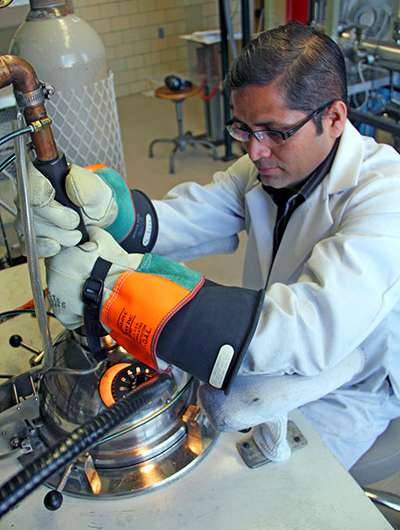Scientists create cheaper magnetic material for cars, wind turbines

Karl A. Gschneidner and fellow scientists at the U.S. Department of Energy's Ames Laboratory have created a new magnetic alloy that is an alternative to traditional rare-earth permanent magnets.
The new alloy—a potential replacement for high-performance permanent magnets found in automobile engines and wind turbines—eliminates the use of one of the scarcest and costliest rare earth elements, dysprosium, and instead uses cerium, the most abundant rare earth.
The result, an alloy of neodymium, iron and boron co-doped with cerium and cobalt, is a less expensive material with properties that are competitive with traditional sintered magnets containing dysprosium.
Experiments performed at Ames Laboratory by post-doctoral researcher Arjun Pathak, and Mahmud Khan (now at Miami University) demonstrated that the cerium-containing alloy's intrinsic coercivity—the ability of a magnetic material to resist demagnetization—far exceeds that of dysprosium-containing magnets at high temperatures. The materials are at least 20 to 40 percent cheaper than the dysprosium-containing magnets.
"This is quite exciting result; we found that this material works better than anything out there at temperatures above 150° C," said Gschneidner. "It's an important consideration for high-temperature applications."
Previous attempts to use cerium in rare-earth magnets failed because it reduces the Curie temperature—the temperature above which an alloy loses its permanent magnet properties. But the research team discovered that co-doping with cobalt allowed them to substitute cerium for dysprosium without losing desired magnetic properties.
Finding a comparable substitute material is key to reducing manufacturing reliance on dysprosium; the current demand for it far outpaces mining and recycling sources for it.
The paper, "Cerium: An Unlikely Replacement of Dysprosium in High Performance Nd-Fe-B Permanent Magnets" was published in Advanced Materials.
More information: "Cerium: An Unlikely Replacement of Dysprosium in High Performance Nd–Fe–B Permanent Magnets." Adv. Mater., 27: 2663–2667. DOI: 10.1002/adma.201404892
Journal information: Advanced Materials
Provided by Ames Laboratory



















